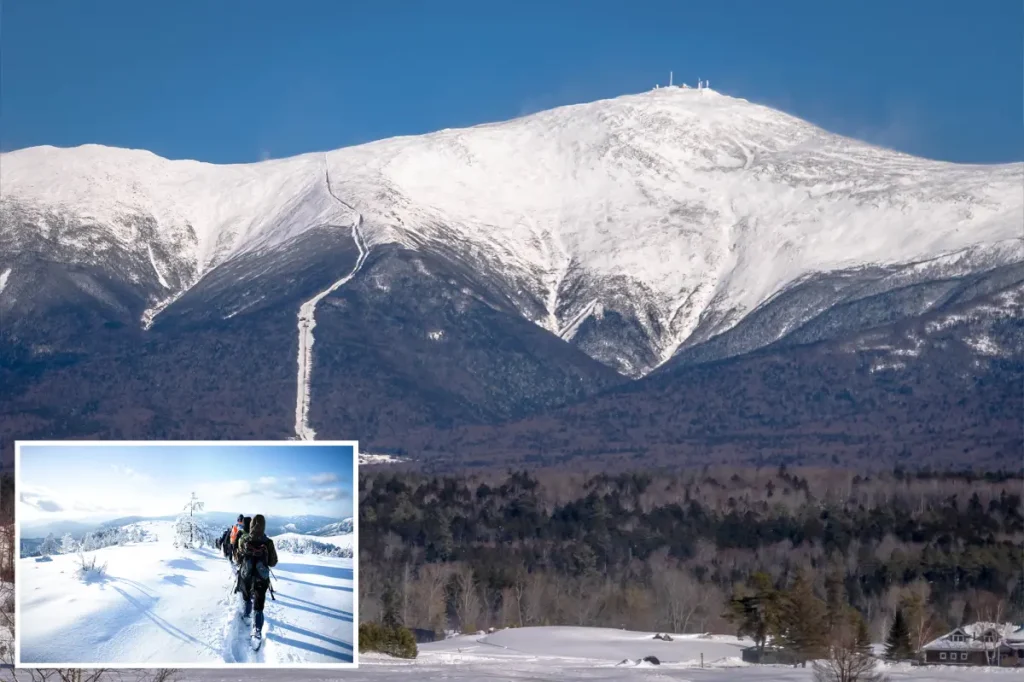Mountain Rescue: Hikers Narrowly Escape Hypothermia on Mount Washington
In a dramatic weekend on New Hampshire’s Mount Washington, over 20 unprepared hikers found themselves in a life-threatening situation, requiring rescue after facing unexpectedly harsh winter conditions on the 6,288-foot summit. The incident, which occurred on a bitterly cold Saturday when temperatures near the summit dropped to between 15-18 degrees Fahrenheit with wind chills as low as minus 5 degrees, highlights the dangers of mountain hiking without proper preparation and research. Andy Vilaine, assistant general manager for the Mount Washington Cog Railway, reported that crew members discovered the distressed hikers while making a routine trip to the summit. Many were already showing signs of hypothermia, wearing inadequate clothing such as non-waterproof layers and sneakers instead of proper hiking boots. Some of the stranded individuals admitted it was their “first hike ever,” having embarked on the challenging trek with little understanding of the mountain’s conditions or the fact that summit services were closed for the season.
The situation could have ended in tragedy had it not been for the timely intervention of the railway crew, who quickly assessed the hikers’ conditions and determined many wouldn’t be able to make the return journey safely. The crew took immediate action, bringing the shivering hikers aboard the train and placing those in more serious condition in locomotive vans with heat blasting to counteract the effects of exposure. This rescue operation underscores a growing concern among local authorities and experienced outdoor enthusiasts about inexperienced hikers venturing into demanding wilderness areas without adequate gear or knowledge. Following the incident, New Hampshire State Parks released a public statement emphasizing the importance of research and preparation: “At 12 pm on October 26, it was 21 degrees with a 30mph wind. The Sherman Adams building at Mount Washington State Park is CLOSED for the season, and there is no shelter,” they warned, adding that multiple unprepared people had required assistance in recent days.
The weekend’s dangers on Mount Washington weren’t limited to the group rescue. In a separate incident just a day later, 20-year-old Owen Strommer of Rhode Island found himself in peril near the summit as daylight faded and his equipment failed. Strommer was less than a mile below the summit on the Tuckerman Ravine Trail when both his headlamp and cell phone began dying, leaving him without light or reliable communication as temperatures dropped to around 21 degrees. Despite attempting to maintain composure during broken phone conversations with authorities, it was clear he couldn’t safely spend the night on the mountain. What followed was a coordinated rescue effort involving conservation officers, a volunteer from the Androscoggin Valley Search and Rescue Team, and a member from Mt. Washington State Park, who drove to the top of the trail to search for the stranded hiker.
Fortunately for Strommer, his slow journey up the trail with his failing headlamp eventually led to safety when he spotted the State Park pickup truck around 8:29 p.m. and was rescued by staff. Authorities noted that while Strommer had done some research before his hike, he was “absolutely unprepared for the conditions that he encountered above treeline.” The New Hampshire Fish and Game Department pointed out that “this situation could have had a very bad outcome, and everyone involved recognized that fact.” After his rescue, a grateful Strommer repeatedly thanked his rescuers, having gained a newfound appreciation for the mountain’s dangers. His experience serves as another sobering reminder that even those who do partial preparation can find themselves in life-threatening situations when mountain conditions turn severe.
These incidents illustrate an important reality about Mount Washington and similar peaks in the White Mountains of New Hampshire: while calendar dates might suggest fall conditions in the lowlands, winter arrives early and harshly at higher elevations. The mountain, known for its notoriously extreme weather, can experience dramatic condition changes that catch inexperienced hikers off guard. What begins as an ambitious day hike can quickly transform into a survival situation when proper equipment, clothing, and emergency supplies are lacking. Conservation officers and park officials continue to stress that anyone venturing into these areas must plan for winter conditions regardless of the season, with the New Hampshire Fish and Game Department bluntly stating that “your life may depend on it.”
The back-to-back rescues on Mount Washington reflect a broader trend seen across many wilderness areas in recent years: an increase in outdoor recreation by individuals without sufficient experience or preparation. Social media posts showcasing spectacular summit views rarely capture the challenges and dangers encountered along the way, potentially giving newcomers to hiking a false sense of accessibility. For those considering tackling mountains like Mount Washington, these incidents serve as powerful reminders to check weather forecasts specifically for higher elevations, research trail conditions and seasonal closures, carry essential survival gear including backup lighting and communication devices, dress in appropriate layers, and always inform someone about hiking plans. The mountain will be there another day, and as New Hampshire State Parks advised in their statement after the group rescue, sometimes the most responsible choice is to “be ‘Wildly Responsible’… or just hike another day.”


